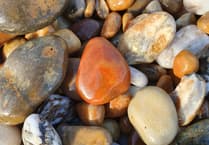Gazing across a view of one of our lovely estuaries with the tide in, it is easy to forget the many complexities of habitat, local conditions and the wildlife communities that thrive there. We see the rolling hills with slopes that steeply fall into the combes between them, the Devon hedges and pockets of woodland above and frequent tree-lined creeks so characteristic of the South Hams but what’s going on below is mostly hidden.
The South Devon National Landscape team are formally reviewing the Estuaries Management Plan over this next year and an important part of this review is that we better understand the natural habitats and communities that we have, where and in what condition they are in and what we can do to help conserve, improve and enhance them. There is an emphasis to enhance things where we can, to work with nature as sustainably as possible for its long-term future … we need it, more than it needs us!
As part of this process, I am presently listing all the main ecosystems within our estuarine systems. Despite having worked in, on and around estuaries for years, even I find it an impressive list. As highlighted here before, every estuary in the country is unique but most at least share many common features - from the water itself and of course the mudflats, to the saltmarshes around them.

New wildlife communities and the habitats that support them are being brought into the plan for the first time … which yes, might be a bit surprising when we consider that this is not the first time that the management plan has been reviewed. This though, is not just one of the wonders of science and discovery but the ability for some things to hide in plain sight. We can’t have missed the beauty of the many tree-lined estuarine banksides, where the trees dip their lower branches down into the water and are so neatly and effectively pruned by the salt in the water but we might have missed pockets of vegetation at the top of slaty and shaly foreshores that have probably always been there in our time but we never noticed them for what they are. These plant communities are described as ‘vegetated shingle’, more normally known from the top of shingle beaches such as that at Strete Gate locally with their deep rooted yellow horned poppies, sea beets and sea kales to name but a few.

Saltmarshes will be highlighted with the aim of furthering the present saltmarsh restoration projects around the Dart and soon to start around the Yealm Estuary. Certainly, within the Management Plan, there will be some actions aiming to help saltmarshes recover where they are eroded and actions to enhance them where conditions allow; there will also be proposals to further enhance our own understanding of their needs and value, how we can respect and care for them. There is an understanding that sometimes we need to experience what we should value, and there is an exciting project to build a local boardwalk with interpretation over such an area in the near future … as they say, watch this space for further details.

As ever, the dangers of invasive and non-native species must be highlighted with reminders of best practice to try to keep these species where they are and prevent them from spreading from waterbody to waterbody. It is important that we all play a part, wherever and whenever we can because cumulative impacts can be positive as well as negative. Within the salty and wet environment, the actions for both being for prevention rather than cure.
I would certainly like us to be doing more for our dwarf seagrass meadows and taking advantage of the rafts of naturally floating plants to effectively ‘reseed’ those estuaries where we think it probably was historically. However, we do have a bit of an ethical dilemma here – should we be reseeding these estuaries when we don’t have actual confirmed records of the dwarf seagrass ever being there? It would be the same if we wanted to restore the estuary bed reefs of native oysters, although here we do find a few individual native oyster individuals, all be they intertidal because that’s where they’re easier to see! We genuinely believe that one of the reasons why we have such poor records of either native oysters or any type of seagrass meadow, is that they were once so common within our shores that they were totally overlooked and under recorded. Those records that do exist tend to be reports of some apparently more notable species being found on seagrass for example. Such are the tremendous ecosystem services of seagrass meadows and native oysters that they might now be justifiable in their own right but if anyone reading this has any memories of seagrasses or native oysters in any number within our local estuaries (with the exception of Salcombe-Kingsbridge for the seagrasses), please let us know!




